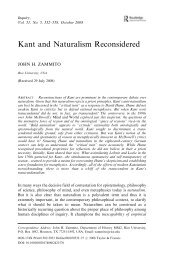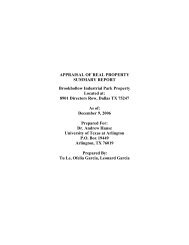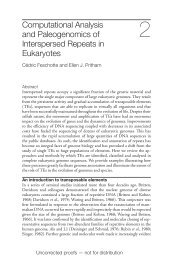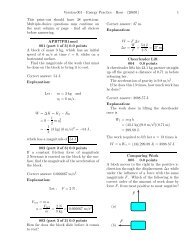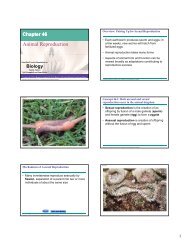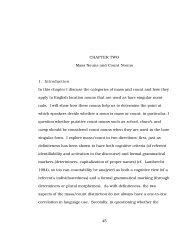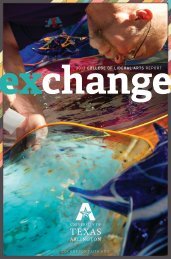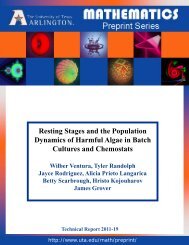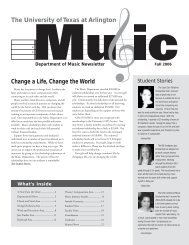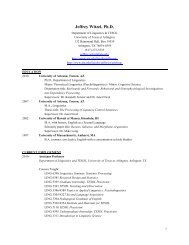You also want an ePaper? Increase the reach of your titles
YUMPU automatically turns print PDFs into web optimized ePapers that Google loves.
<strong>Turtles</strong> are a group of reptiles at their evolutionary zenith<br />
Currently there are 13 different families represented by approximately 300 species<br />
<strong>Turtles</strong> are found in every region of the world except for the extreme Polar regions<br />
There are 29 species and 7 different families of turtles living in Texas
<strong>Turtles</strong> are the only vertebrate with a shell<br />
The ribs are fused into the inside of the shell<br />
<strong>Turtles</strong> have a urinary bladder<br />
<strong>Turtles</strong> do not possess teeth. Instead they utilize a sharp cusp to cut off pieces of food<br />
<strong>Turtles</strong> have well developed hearing and eyesight
Male turtles and crocodilians are the only reptiles with a penis for a copulatory organ<br />
Females lay eggs. eggs The number of eggs produced produced depends upon the age size and species<br />
of turtle laying the eggs. Clutch size may vary from 2‐100+<br />
Males often locate females by sight and then confirm their sex by smell and behavioral<br />
cues<br />
T tl l t h t it d t<br />
<strong>Turtles</strong> are slow to reach maturity and must<br />
produce several offspring each year in order to<br />
maintain the survival of the species
Females often nest under the cover of darkness and they may dig a number of holes<br />
before finally laying their eggs.<br />
The sex of most turtles is dependent upon their temperature during incubation<br />
Upon hatching the young turtle uses an egg tooth (caruncle) to cut open the egg shell.<br />
Hatching usually occurs during the late summer and depending upon the hardness of<br />
the ground, hatchlings may remain buried until the arrival of spring rains
With the exception of most tortoises, turtles are largely omnivores and opportunistic<br />
consumers of a variety of food items.<br />
Most freshwater species (except for the soft shell turtles and the mud and musk turtles)<br />
will consume vegetative matter including aquatic plants, fallen fruits and algae<br />
Some have adapted interesting feeding strategies to secure fish<br />
Most freshwater species are simply not fast enough to capture healthy fish<br />
The perception of turtles being a pest or nuisance are most often false. The idea of<br />
nuisance turtles is often promoted by businesses dealing with the sale of native turtles<br />
to Asian food markets.<br />
Many of the fish captured by turtles are old or unhealthy. The removal of these fish<br />
essentially increases the health of the fish population
Like all reptiles, turtles are cold blooded and their internal body temperature is dictated<br />
by the temperature of their environment.<br />
Most aquatic species devote considerable amounts of time to basking in the sun<br />
This not only increases the body’s metabolic function by raising the body temperature, it<br />
also helps rid the body of external parasites and excess algae
Texas turtles are often active throughout the year except for exceptionally cold winters<br />
and hot and dry summers<br />
<strong>Turtles</strong> often wander about in search of ideal<br />
nesting sites and better locations to live. The<br />
peak k level l lof f activity i i occurs ffrom spring i to<br />
autumn
Fossil record dates back to the Triassic some 245 million years ago<br />
Texas turtles have a well documented fossil record with some of the most remarkable specimens found in Cretaceous<br />
Texas turtles have a well documented fossil record with some of the most remarkable specimens found in Cretaceous<br />
deposits
•<br />
The sea turtles Family Cheloniidae<br />
• Sea turtles of the family Cheloniidae represent a wide spread group of turtles that occur in virtually all of the<br />
worldʹs temperate and tropical seas. Throughout the world, five genera and six species are known to exist. In<br />
Texas, four different species have been found in the Gulf coast and on its shores. These large turtles have a<br />
carapace covered in keratinized scutes and depending upon the species can range in size from 30 inches (100 cm)<br />
to 39 inches (124 cm) and weight as much as 95 pounds (43 kilograms to 400 pounds (200 kg).<br />
• Sea turtles are highly specialized for an aquatic life in a marine environment. The most noticeable difference<br />
between sea turtles and most other turtles are the fore and hind limbs which have been modified into<br />
flippers. The physiology of these reptiles is also of interest as sea turtles must effectively regulate the amount of<br />
salt taken into their bodies. Salt secretion glands located near the corner of the eye help rid the body of excess<br />
salts.<br />
• Males rarely, if ever leave the water. Coming ashore is mostly a task reserved for the females as they continue the<br />
millennia old ritual of females returning to the same nesting beaches that they hatched from<br />
themselves. Depending upon the species, females can lay 50‐160 leathery round eggs. Females come to shore<br />
under the cover of darkness to lay their eggs<br />
• Sea turtles are facing eminent extinction due to man made pressures ranging from pollution, incidental deaths<br />
from the fishing industries and the direct take of eggs and slaughter of adults for food.<br />
• The Sea <strong>Turtles</strong>: Family Cheloniidae<br />
• The Loggerhead sea turtle (Caretta caretta)<br />
• The Green sea turtle (Chelodina mydas)<br />
• Hawksbill sea turtle (Eretmochelys imbricata)<br />
• Atlantic Ridley (Lepidochelys kempii)
Green sea turtle (Chelonia ( mydas) y )
Kemp’s p Atlantic Ridley y (Lepidochelys ( p y kempii) p )
•<br />
•<br />
Family Chelydridae The Snapping <strong>Turtles</strong><br />
Chelydrid turtles are undeniably easy to recognize. The family Chelydridae is represented by two species, the<br />
common snapping turtle (Chelydra serpentina) and the alligator snapping turtle (Macrochelys temminckii).<br />
• Today members of the family Chelydridae are found in the Western Hemisphere, and primarily in the Northern<br />
Hemisphere. However it should come as little surprise that such a prehistoric looking family of turtles has a fairly<br />
well documented fossil history. dating back to the Paleocene with the discovery of Protochelydra zangleri.<br />
• Common snapping turtle (Chelydra serpentina)<br />
• Alligator snapping turtle (Macrochelys temminckii)<br />
• Snapping turtles can be found in various habitats. These photos were both taken in Anderson County, Texas. One<br />
ddepicts i t a swamp ( (above b lft) left) and d th the other th ddepicts i t a seasonally ll flooded fl d d forest. f t Whil While th the swamp provides id a more<br />
permanent habitat for these turtles heavy rains can cause the water levels in creeks, rivers and lakes to rise often<br />
flooding adjacent areas. This is one manner by which these turtles relocate to different habitats. Both the common<br />
and alligator snapping turtle have been found in Anderson County, Texas.
Family Dermochelyidae Dermochelys coriacea The leatherback sea turtle
Family y Emydidae: y Box turtles, Cooters, Painted turtles, Sliders and Terrapins p
• Family Emydidae: Box turtles, Cooters, Painted turtles, Sliders and Terrapins<br />
• Members of the family Emydidae are probably the most commonly encountered family of turtle in Texas. Seen crossing roadway<br />
wandering in fields, basking on logs or swimming in various bodies of water emydid turtles represent the greatest diversity of tur<br />
in Texas.. Within Texas representation of this family is comprised of 7 genera and 14 species.<br />
• Western painted turtle (Chrysemys picta belli)<br />
• Southern painted turtle (Chrysemys picta dorsalis)<br />
• Western Chicken turtle (Deirochelys reticularia miaria)<br />
• Cagleʹs map turtle (Graptemys cageli)<br />
• Sabine map turtle (Graptemys ouachitensis sabinensis)<br />
• Mississippi map turtle (Graptemys pseudogeographica kohnii)<br />
•<br />
Texas map turtle (Graptemys versa)<br />
•<br />
Texas diamondback terrapin (Malaclemys terrapin littoralis)<br />
• River cooter (Pseudemys concinna)<br />
• Rio Grande river cooter (Pseudemys gorzugi)<br />
• Texas river cooter (Pseudemys texana)<br />
• Big Bend slider (Trachemys gaigeae)<br />
• Red eared slider (Trachemys scripta elegans)<br />
• Three toed Box turtle (Terrapene carolina triunguis)<br />
• Ornate Box turtle (Terrapene ornata)<br />
• Desert Box turtle (Terrapene ornata luteola)
The Western Chicken Turtle (Deirochelys reticularia miaria)
Cagleʹs map turtle (Graptemys cageli)
Mississippi map turtle (Graptemys pseudogeographica kohnii)
River cooter (Pseudemys concinna)
Rio Grande river cooter (Pseudemys gorzugi)
Ornate box turtle (Terrapene ornata)
Big Bend slider (Trachemys gaigeae)
Red eared slider (Trachemys ( y scripta p elegans) g )
• Family Kinosternidae: Mud and Musk turtles<br />
• The family y Kinosternidae consists of two genera g and twenty y three species. p Four species p belong g to the genus g<br />
Sternotherus (musk turtles), and nineteen belong to the genus Kinosternon (mud turtles). The family Kinosternidae<br />
is distributed from southeastern Canada to the United States east of the Rockies and southward to Brazil. These<br />
are small turtles, with the largest species in Texas achieving a maximum length close to 7 inches (** cm).<br />
• Members of this family are aquatic and sometimes seen patrolling the bottoms of brackish marshes, creeks,<br />
flooded fields, lakes, ponds, and rivers. Mud and musk turtles engage in moderate amounts of basking. However,<br />
because the turtles turtles’ lifestyle causes significant algae growth on their shells shells, observers occasionally mistake an<br />
algae‐covered turtle for a rock. Kinosternid turtles are capable of remaining submerged underwater without<br />
surfacing for several minutes. Their underwater ability is due in a large part to buccopharyngeal respiration.<br />
• Mud and musk turtles have a carapace that is oval‐shaped and has twenty‐three marginal scutes including the<br />
cervical scute. The plastron has ten to eleven scutes and may have a flexible hinge.<br />
• As evidenced by fossil material, the family Kinosternidae has been around for a long time. A fossil of Xenochelys<br />
formosa was discovered in deposits in South Dakota that dated to the Oligocene Epoch (23 million to 38 million<br />
years ago). This specimen is the oldest known representative of the family.<br />
• 2 genera and 5 species of kinosternid turtles are found in Texas.<br />
• Yellow mud turtle ( Kinosternon flavescens)<br />
• Big Bend mud turtle (Kinosternon hirtipes murrayi)<br />
• Mississippi mud turtle ( Kinosternon subrubrum hippocrepis)<br />
• Razorback musk turtle (Sternotherus carinatus)<br />
• Common musk turtle or Stinkpot (Sternotherus odoratus)
Yellow mud turtle (Kinosternon flavescens)
Mississippi mud turtle (Kinosternon subrubrum hippocrepis)
Common Musk turtle or Stinkpot (Sternotherus odoratus)
Texas tortoise (Gopherus berlandieri)
Family Trionychidae: The Soft shelled turtles
Family Trionychidae: The Soft shelled turtles<br />
• With fifteen genera and thirty species species, the family Trionychidae occurs throughout most of the world world. These distinctive<br />
turtles have a range that includes North America, Africa, southern and eastern Asia, and the East Indies to New Guinea.<br />
Fossil records from the late Jurassic Period provide evidence that this family’s distribution once included Europe and<br />
South America.<br />
• One genus and four species comprise the soft-shelled turtle diversity in North America. In general, North American softshelled<br />
turtles are moderately y sized. The Florida soft-shelled turtle (Apalone ( p ferox) ) attains the largest g size at 25 inches ( (63<br />
centimeters). This species has a distribution that includes southern South Carolina, central Georgia, eastern Alabama, and<br />
Florida.<br />
• The smooth soft-shelled turtle (Apalone mutica) is one of two species inhabiting the central United States and reaches<br />
14 inches (35 centimeters) in carapace length. Unlike its cogener, the spiny soft-shelled turtle (A. spinifera), this species<br />
lacks tubercles on the anterior portion of its carapace.<br />
• The spiny soft-shelled turtle has the widest range of all the North American soft-shelled turtles. This species has a<br />
geographic distribution that includes southern Ontario and Quebec, Canada, to northern Florida westward to Montana and<br />
southeastern California. It also occurs south of the Rio Grande in Juarez, Coahuila, Nuevo Leon, and Tamaulipas, Mexico.<br />
• Two species of soft shell turtle occur in Texas.<br />
• The smooth soft shell turtle (Apalone mutica)<br />
• The spiny soft shell turtle (Apalone spinifera)
After more than 200 million years, turtles are currently facing possible depletion and<br />
extinction unlike any other period in known history<br />
Their problems are caused by human activity<br />
Loss of habitat, road way mortality, collection for the pet trade and harvest for the<br />
Asian food markets can seriously deplete and extirpate populations<br />
Thousands of turtles are currently harvested from public and private waters and sold<br />
as “sea food” to China. This activity y has already y depleted p much of southeast Asia’s<br />
turtle populations and now the Chinese are seeking turtles from other countries.<br />
The take of turtles from the wild for a source of food is unsustainable<br />
Our turtles should be a source of interest and pride in the natural history and<br />
heritage of Texas
Don’t buy wild caught turtles. Most pet stores sell wild caught turtles if you decide<br />
to acquire a pet turtle purchase one from captive bred stock or adopt one from an<br />
animal rehab.<br />
Don’t eat Texas turtles. Asides from the aspect of unsustainability, turtles<br />
accumulate and retain more toxins and pollutants pollutants (methyl mercrury mercrury, pcbs pcbs, etc) in<br />
their bodies than fish.<br />
Help the turtle cross the road. <strong>Turtles</strong> don’t know what cars are and their shells<br />
always burst when hit by a vehicle resulting in a painful and unnecessary death



